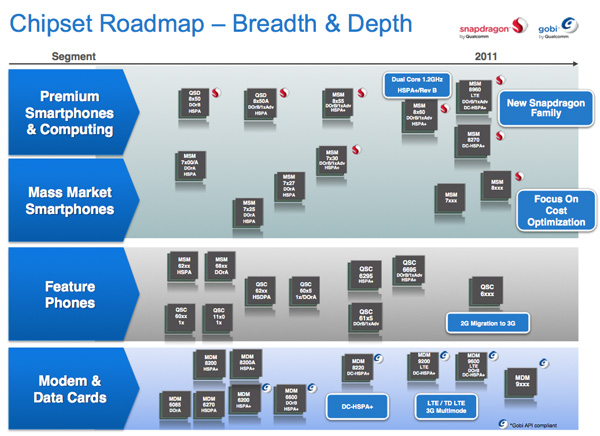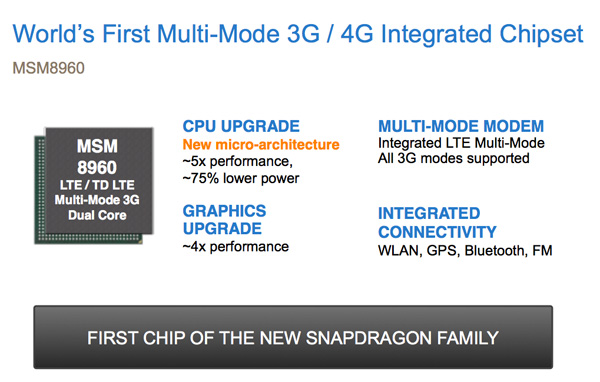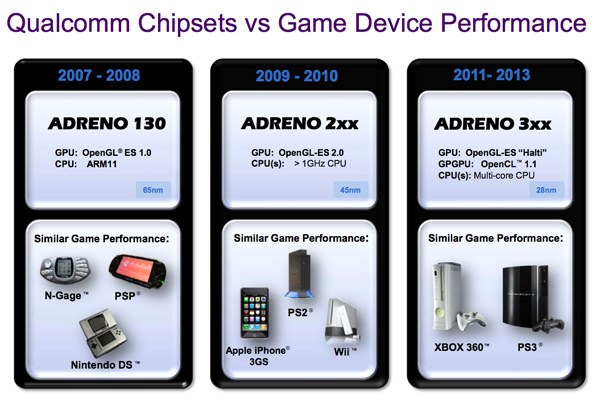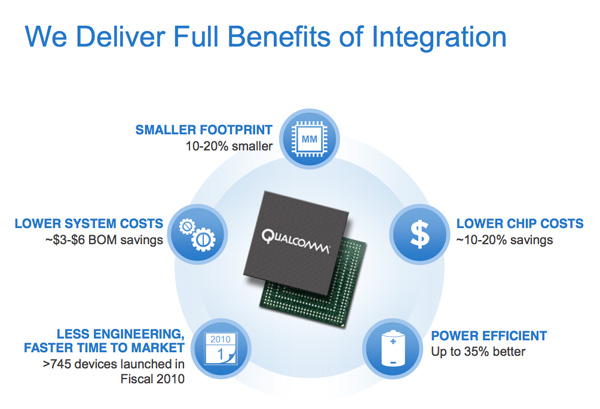Qualcomm Reveals Next-Gen Snapdragon MSM8960: 28nm, dual-core, 5x Performance Improvement
by Anand Lal Shimpi on November 17, 2010 11:00 PM EST- Posted in
- Smartphones
- Snapdragon
- Qualcomm
- MSM8960
- Adreno
- Mobile
- SoCs
Earlier today Qualcomm briefed analysts on its Snapdragon SoC roadmap. The current Snapdragon is available in both 65nm and 45nm versions integrating a single Scorpion CPU core running at up to 1GHz and an Adreno 200 or 205 GPU (respectively). Snapdragon was the SoC of choice for many Android phones over the past year and a half, not to mention the only SoC available in Windows Phone 7 devices.
In the coming months we’ll see the first dual-core Cortex A9 based NVIDIA Tegra 2 SoCs ship in devices. Sometime next year we’ll see A9 based OMAP4 SoCs in smartphones as well. So what does Qualcomm have in store for us over the next few years?
First we have the MSM8260 and 8660 SoCs. These are based on Qualcomm’s current generation technologies: integrating two Scorpion cores and an Adreno 205 GPU on a single 45nm die. The 8260 features HSPA+ support, while the 8660 supports HSPA+, CDMA2000 and 1xEV-DO Rev. B. These two dual-core SoCs will run at 1.2GHz. We should see a GPU upgrade here as well.
The 8x60 SoCs started sampling over the summer and we should expect to see them in high end smartphones sometime in 2011 at the earliest.
More exciting however is what comes next. Today’s disclosures included further details for the next-generation Snapdragon SoC built on a 28nm process. The first member of the next-gen Snapdragon family is the Qualcomm MSM8960 SoC.
Inside the MSM8960 are two next-generation processor cores, presumably out-of-order as Qualcomm is promising 5x the performance of the original Snapdragon chip (2x for the move to dual cores and the rest due to OoO, larger caches and other architectural tweaks perhaps?). Qualcomm isn’t disclosing clock speed at this time.
Power consumption is said to be 75% lower, however that seems very aggressive compared to what we have today. It’s unclear if Qualcomm is talking about active or idle power, or what version of Snapdragon it is comparing to (65nm or 45nm).
On the GPU side Qualcomm is making significant performance claims as well. The MSM8960 is set to offer a ~4x improvement in graphics performance. Again, Qualcomm wasn’t specific about what the reference point was. If it’s compared to the Adreno 200, that would imply a doubling of the GPU performance we have today.
Qualcomm has separately announced that the Adreno 3xx GPU would be used in SoCs from 2011 - 2013 on a 28nm process. This appears to be the GPU family used in the next-generation Snapdragon. Even more interesting is Qualcomm stating that Adreno 3xx will have performance similar to the Xbox 360/PS3.
If that’s indeed the level of graphics performance we’ll see in the next 3 years, being able to play Xbox 360 titles on Windows Phone 8 may not be too far fetched.
The 8960 continues to be a single chip solution with integrated modem, supporting all 3G modes as well as LTE. The MSM8960 will begin sampling in 2011, meaning we likely won’t see smartphones based on it until 2012.




















48 Comments
View All Comments
Khato - Thursday, November 18, 2010 - link
Which is why Intel is set to acquire Infineon's wireless division, which gives them access to the 3G/LTE and more for proper integration - http://www.intel.com/pressroom/archive/releases/20...Intel's offerings next year will start to be competitive in the market, while by 2012 I'd expect the level of integration and process tech advantage to be such that it could be better than other available options. Very interesting competitive landscape coming up, that's for sure.
T2k - Thursday, November 18, 2010 - link
Intel has NOTHING when it comes to this low-power technology - x86 simply won't work, EVER, period. The reason is that to match Qualcomm in performance/watt Intel/x86 needs one generation advantage in mfr'ing process which will never happen ie on the same process Qualcomm will always beat x86/Intel, period.sleepeeg3 - Thursday, November 18, 2010 - link
Minor details... I'll bet the dual core, 1.2 GHz chip consumes at least twice as much power. Would like to see a website that graphed the battery life of various cell phone chips under difference mobile phone OSes. All the rage seems to be about FASTER, but I would rather see the PHONE go a month without a charge than see it run Flash on a dinky 4", 64k screen with a $480/year data plan. That's what computers are for.Exodite - Thursday, November 18, 2010 - link
"I'll bet the dual core, 1.2 GHz chip consumes at least twice as much power."And you'd likely be wrong, definitely at 28nm. Besides, even if it did it'd complete a workload in less than half the time so there's a net gain in battery time.
If you worry about battery time in your mobile device you should be moving your focus from the SoC to the display as display manufacturers are really the ones you should be hounding about energy conservation.
Klinky1984 - Thursday, November 18, 2010 - link
Umm, hate to ruin your whining but there are a ton of phones out there that can go a week or so between charges, just not any of these whizbang smartphones you seem to despise. So go get yourself an old Motorola or Nokia and quit your whining.Visual - Thursday, November 18, 2010 - link
Galaxy S "whizbang" goes a week and more easily too, if I use it just as "an old Motorola or Nokia", i.e. no 3G or wifi or bluetooth or movies or games.Goes a day with non-stop music playing over stereo bluetooth headset, and that's fine for me too - the headset itself is also drained by then and I charge them both together.
zebrax2 - Thursday, November 18, 2010 - link
You should really look at philips xenium series of phonesglad2meetu - Thursday, November 18, 2010 - link
This Qualcomm marketing presentation is very misleading. Claims of 4x performance and 75% leakage reduction are well beyond a 40nm to 28nm spin. The architecture information is not correct. Having two cores does not give 2x performance increases, you get about 1.25x if the application code is able to run on multiple cores (4 cores is about 1.4x, 8 cores is about 1.5x). Given their stock went up today, I will rate Qualcomm as a sell on the stock market based on this misleading information and the fact that the stock went from $32 a share in July 2010 to $48 a share in Nov 2010. Fair market value for QCOM is probably about $40 a share. Even at $40 a share, they have outperformed the market. Overall, I except QCOM to do well compared to the S&P500 since the profit margins are good. But I think they are overpriced at the moment.DigitalFreak - Thursday, November 18, 2010 - link
Yeah, I'm going to take stock market advice from the Anandtech comments section...Shadowmaster625 - Thursday, November 18, 2010 - link
lol just before I read your reply I was thinking QCOM has a pretty nice setup on the weekly. $55 before february wouldnt surprise me.